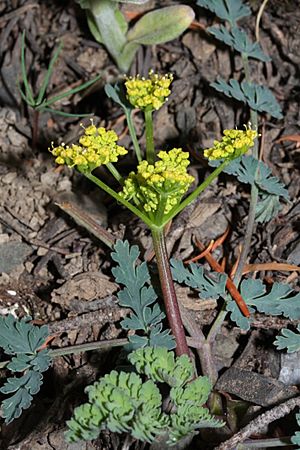Cascade desertparsley facts for kids
Quick facts for kids Cascade desertparsley |
|
|---|---|
 |
|
| Scientific classification | |
| Kingdom: | |
| (unranked): | |
| (unranked): | |
| (unranked): | |
| Order: | |
| Family: | |
| Tribe: |
Selineae
|
| Genus: | |
| Species: |
L. martindalei
|
| Binomial name | |
| Lomatium martindalei J.M.Coult. & Rose
|
|
Lomatium martindalei is a type of flowering plant in the carrot family. It has a couple of common names: Cascade desertparsley and coast range lomatium. This plant naturally grows along the west coast of North America. You can find it from Vancouver Island in Canada all the way south to the Klamath Mountains in northern California.
About Cascade Desertparsley
This interesting plant can be found in many different places. It grows in coastal areas, like flat plains near the ocean. It also thrives in high mountains, often on rocky slopes called talus, and in green meadows.
What It Looks Like
The Cascade desertparsley is a perennial herb. This means it lives for more than two years. It usually grows to be about 15 to 40 centimeters tall. That's roughly the height of a school ruler!
The plant grows from a thick taproot that looks a bit like a carrot. Often, you won't see a main stem above the ground. Instead, its leaves and flowers grow directly from the ground level.
Leaves and Flowers
The leaves of this plant can be quite long, sometimes up to 20 centimeters. They are thin and fleshy. Each leaf is divided into many smaller leaflets. These leaflets are made up of tiny, oval-shaped parts.
When it blooms, the plant produces an inflorescence (a cluster of flowers). This cluster forms an umbel, which looks a bit like an umbrella. The small flowers are usually yellowish in color.

